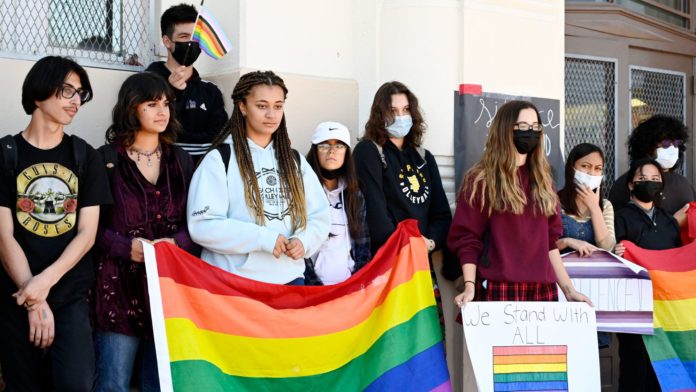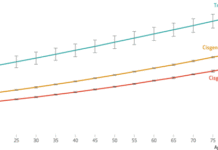/US-LGBTQ-Dont-Say-Gay-Students-GettyImages-1393028066-2000-48f021de2e204dbd86421d15f53a0e21.jpg)
Fact checked on June 14, 2022, by Vivianna Shields, a journalist and fact-checker with experience in health and wellness publishing.
Mental health professionals and child health advocates are worried by the deluge of anti-LGBTQIA+ bills introduced in state legislatures over the past two years. They say the measures stigmatize young people, putting their mental well-being at risk.
Florida’s “Parent’s Rights in Education” act, also known as the “Don’t Say Gay or Trans” law, has garnered much of the attention. Effective July 1, the measure prohibits classroom instruction and discussion of sexual orientation and gender identity in kindergarten through third grade. In practice, opponents of the law say it could squelch affirming and inclusive discussions in the classroom.
It’s not the only type of legislation clinicians and researchers worry about.
“I think the really big story is just the breadth and the speed at which anti-trans policies are popping up in states all over the country,” Jessica N. Fish, PhD, assistant professor in the Department of Family Science at the University of Maryland School of Public Health, told Health.
The implications for kids and families are worrisome, say mental health professionals. “It definitively emphasizes to them that the environment that they’re living in doesn’t want them, let alone welcome them,” said Michael Parent, PhD, associate professor in the Department of Educational Psychology at the University of Texas at Austin. He worries the measures may empower people to “discriminate against, harass, and bully” LGBTQIA+ youth.
That’s the kind of environment that can put kids who are already feeling stressed at even greater risk, experts said.
“We’re in the middle of a mental health crisis to begin with,” Myo Thwin Myint, MD, associate professor of psychiatry and pediatrics at Tulane University School of Medicine, told Health. “We know that our LGBTQ youth actually experience a disproportionate burden of it.” While research shows that being gay or trans doesn’t cause depression or anxiety, “social acceptance—or lack thereof—is a risk factor,” Dr. Myint explained.
The Human Rights Campaign (HRC), an LGBTQIA+ civil rights group, evaluated more than 660 potentially LGBTQIA+-related bills introduced or pending action by state legislatures in 2022. More than 340 of those bills were found to have “harmful impacts” on the LGBTQIA+ community as a whole. Of those, 24 measures have been passed into law in 13 states.
Half of those laws are anti-trans sports bans, like Louisiana’s newly enacted measure prohibiting trans women and girls from playing on female sports teams. It is the 18th state to ban trans students from participating in sports consistent with their gender identity. Although opposed to the measure, Democratic Gov. John Bel Edwards said he allowed it to become law given that his veto would likely be overridden by the Republican-controlled legislature.
At a June 6 press conference, Edwards said the law’s effect, whether intended or not, is to “send a strong message to at least some of these young people that they shouldn’t be who they think they are, who they believe they are, who they know that they are. And I find that very distressing. I do believe that we can be better than that.”
Four states (Alabama, Florida, Georgia, and South Dakota) have adopted what HRC calls “curriculum censorship” or “anti-LGBTQ+ educational provisions” this year. Alabama and Oklahoma enacted “anti-trans bathroom bills.” Two states (Alabama and Arizona) passed “anti-trans medical care bans.”
“A second-grader may not know they’re LGBTQ, but they’re sure as heck getting the message that it’s not OK,” said Fish.
In March, the American Academy of Child and Adolescent Psychiatry (AACAP) issued a statement calling out Florida’s “Don’t Say Gay or Trans” legislation, saying it stigmatizes LGBTQIA+ youth and families. AACAP President Warren Ng, MD, called it unconscionable to target this population amid a national crisis in youth mental health.
The Trevor Project’s 2022 National Survey on LGBTQ Youth Mental Health captures the severity of the situation. Forty-five percent of LGBTQIA+ youth seriously considered suicide in the past year, it reported. LGBTQIA+ youth who have been physically threatened, harmed, or discriminated against due to their sexual orientation or gender identity were more likely to attempt suicide than peers who have not had these experiences.
Anit-LGBTQIA+ legislation adds stress to an already difficult situation. According to the Trevor Project, the majority of transgender and nonbinary youth worry about laws limiting access to gender-affirming medical care, banning transgender participation in sports consistent with gender identity, and probiting use of bathrooms that align with gender identity.
Clinicians are worried, too. In March 2021, researchers at the University of Michigan School of Public Health surveyed 103 providers of gender-affirming care from all 50 states. Nearly every provider indicated that laws limiting the care they can provide would adversely impact the mental health of transgender and gender-diverse youth. “Providers mentioned that they would see an increase in suicide/ideation, depression, anxiety, gender dysphoria, and addiction among their patients,” researchers reported in May 2022 in the Journal of Adolescent Health.
“Teenagehood is difficult for all kids,” Parent said. “But when they’re facing individual-level and system-level outright harassment and bullying from other people—and then from the state itself, that would exacerbate any kind of mental health concerns they’re having.”
Conversely, school policies and practices that protect and affirm the gender identity of transgender and gender-diverse youth, such as anti-bullying and nondiscrimination measures, are associated with positive mental health and academic outcomes, reports the Society for Research in Child Development. A 2018 study in the Journal of Adolescent Health found that transgender youth who could use their chosen name in school were less likely to report depression and suicidal thoughts.
And LGBTQIA+ youth aren’t the only ones affected by policies that curb classroom discourse or put other bans in place: Imagine the child with two moms navigating the Father’s Day gift-making project in school and not feeling free to talk about it. Or the teacher afraid to mention their same-sex partner, the youngster whose older sibling is gay, the parents worried about supporting their gender-nonconforming child.
It’s not just about prohibiting sex education, Fish said. It’s about children and the adults around them being able to talk about their families and showing “different ways of being in this world,” she said.
There may not be large studies examining how the current crop of anti-LGBTQIA+ laws is affecting youth mental health. But there is research showing that policies and laws can really make a difference, Fish noted. In one study, researchers found that lesbian and gay youth living in counties where fewer school districts maintain inclusive anti-bullying policies were more likely to have attempted suicide in the past year than those living in places where more of these policies exist.
There also are lessons to be drawn from the not-too-distant past, when being part of the LGBTQIA+ community was considered taboo, said Myint. “We can actually look back at our histories and how it has affected the LGBTQ youth,” he said.
History tells us that adolescents who are bullied or harassed may turn to alcohol or drugs (although not everyone who experiments will develop a substance use disorder), noted Dr. Myint. Young children, who don’t always have the words to express how they’re feeling, might perform poorly in school, become withdrawn, or appear frustrated or irritable, he said.
Feeling like they’re not going to be accepted for who they are sets up a trajectory for bad mental health, Parent noted. “Even if they have great parents that are very affirming, it would be like any of us working at a job, only to go in every day and be harassed.”
There are a handful of resources available for both adolescents in crisis or need of support and adults that may be concerned about their child’s mental health. The Trevor Project is a suicide prevention group that provides free, confidential crisis counseling to LGBTQIA+ youth; and Q Chat Space is an online community for LGBTQIA+ youth to connect with their peers. Trans Lifeline operates a peer-support hotline run by trans people, and the LGBT National Youth Talkline provides peer support for youth and young adults. Meanwhile, PFLAG aims to support, educate, and advocate for LGBTQIA+ people and their families.
If you’re looking for an LGBTQIA+-affirming therapist, review the American Psychological Association‘s tips for parents and guardians of gender-diverse children and adolescents. Using the APA’s provider locator, you can search for a psychologist whose practice area includes LGBTQIA+ issues. The National Queer & Trans Therapists of Color can help with finding a mental health provider in your area, or visit the Association of LGBTQ+ Psychiatrists to search its database of LGBTQIA+-friendly psychiatrists.
In an emergency, the National Suicide Prevention Lifeline, at 1 (800) 273-8255, offers 24/7 support.








